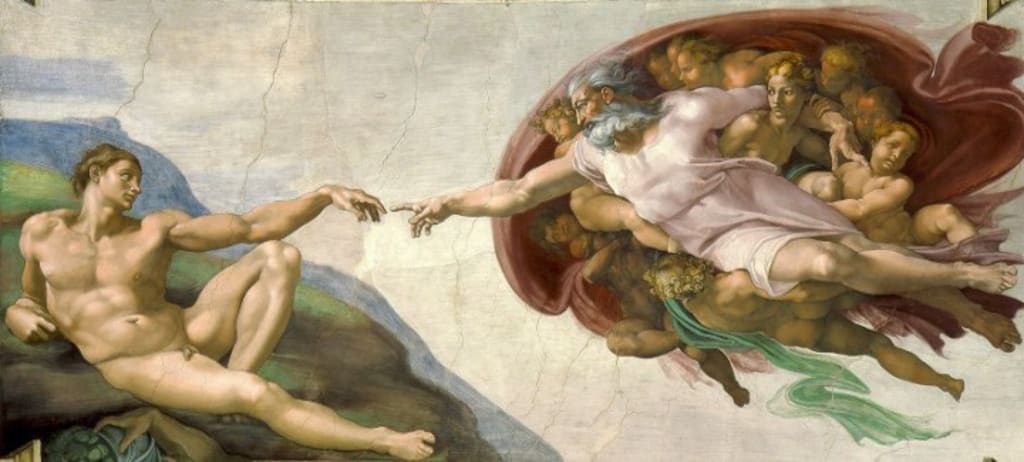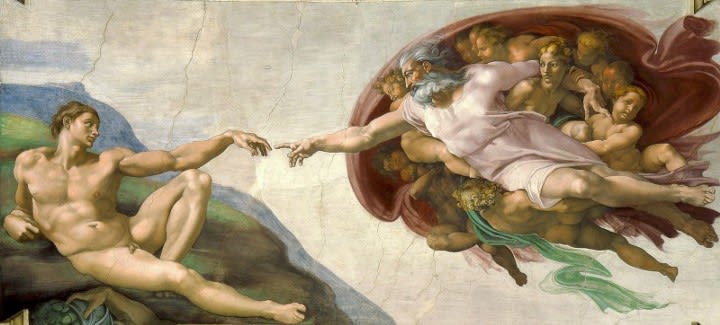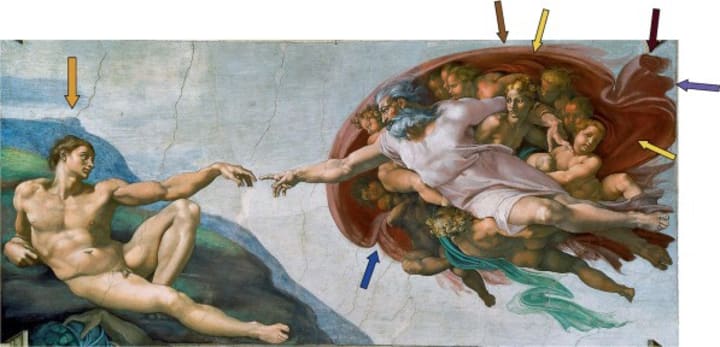3 Paintings For Science, Mathematics & Psychology Lovers
Genius interpretations otherwise hidden from the naked eye

1. Creation of Adam by Michelangelo (1508–1512)

Michelangelo's Creation of Adam is a treasure trove that continues to inspire artists and scientists for centuries after his death.
Although at first glance this painting depicts the biblical narrative, if we immerse deep into the artwork, we can understand creation and the laws of energy - a classic example of how Michelangelo encompassed the creation of the human race in one painting.
This composition is chronologically the fourth in the series of intricate panels depicting the episodes of Genesis in the Sistine Chapel ceiling.
It reflects Michelangelo's incredible knowledge of human anatomy. His experience in anatomical dissection is well documented by Renaissance artist Giorgio Vasari in Lives of the Artists.
It all started when Michelangelo, at the age of 17, began dissecting corpses from the Church graveyard.
• The first thing most people note about God creating Adam is that the fingers don't touch. And rightly so - there was no need for physical contact to be made because Adam was created in a universe where thought alone controlled the outcome.
• God is portrayed as an elderly white-bearded man floating in the ether while Adam is on the ground. God faces down, Adam faces up. God is clothed, Adam is naked. God reaches with the right hand, Adam with his left - a way of representing a balance.
Art historians have provided many interpretations of this painting. Here, I'd share the most credible and widely accepted meaning.
The portrayal of the human brain
• Notice the positioning of God in the painting. He resides right within the shape of the human brain. The figure of God juxtaposed with the human brain is the most common interpretation of the painting.
• In 1990, physician Frank Meshberger in Anderson, Indiana, pointed out that the shape portrayed behind the figure of God anatomically matches the human brain. The borders in the painting correlate with the frontal lobe, optic chiasm, brainstem, pituitary gland, and the major sulci of the cerebrum.
• Such anatomical accuracy with the brain's structure is one of the greatest revelations in this painting. Michelangelo being a religiously scientific man, and one of the greatest artists of all time tried to explore the mysteries of the human brain and biblical narrative in the same fresco.
• The biblical narrative was to please his patrons and the church. While the anatomically accurate portrayal of the painting was to satisfy his own scientific curiosity.
The portrayal of the human birth process

Another research published was by a group of Italian researchers who interpreted God situated in a postpartum uterus of a woman and Adam lying on a woman's torso.
1. The brown arrow represents God's figure juxtaposing with the postpartum uterus.
2. The yellow arrows resemble the folds of the mucosa of the uterus in the postpartum period. The folds seem to appear only after the delivery and retraction of the uterus muscle.
3. The blue arrow represents the uterine cervix.
4. Adam seems to be resting on what looks like a rock which in ancient iconography portrays generating mother. The orange arrow just above Adam depicts the nipple of a female body.
5. And, the green-colored scarf hanging out signifies the newly cut umbilical cord.
You would think that if somebody was painting God next to a mere mortal, God should be portrayed as infinitely bigger and have a status that would place man as a small insignificant being.
But not in Michelangelo's painting.
Instead, we see humankind, represented by Adam, pretty much the same size as God - a balancing force to God's power but one that nonetheless was 'created' or 'derived' from that very same source.
---
2. The Scream by Edvard Munch (1893)
22 January 1892, Munch wrote in his diary -
"I was walking along the road with two friends - the sun was setting - suddenly the sky turned blood red - I paused, feeling exhausted, and leaned on the fence - there was blood and tongues of fire above the blue-black fjord and the city - my friends walked on, and I stood there trembling with anxiety - and I sensed an infinite scream passing through nature."
Munch's inspiration for the painting came from an evening walk when the sky began to turn blood red and he was trembling with anxiety as he felt an "infinite scream" through nature.
His childhood was shaped by trauma and sickness. His mother and sister died of tuberculosis when he was 15.
He wanted to pursue art but his traditional Catholic father did not allow him.
His father and grandfather suffered from depression. Another sister Laura suffered from schizophrenia.
He was a sickly child always.
In 1884, he joined Kristiania Bohemians circle, led by anarchist writer Hans Jaeger.
Jaeger promoted rejecting religion and moving away from bourgeois principles.
Self Portrait in Hell and Anxiety and Death in the Sickroom are some of his paintings portraying the human emotions of sorrow, anxiety, fear, and melancholy
Now back to the painting,
• Under a blood-red sky, a terrifying figure with a skull-like face is staring out at us. Scientists have linked this to nacreous cloud formations common in Norway during winter which is when Munch painted The Scream.
• Art historians find the actual place to be Ekeberg which overlooks Oslo Fjord. Munch was not there for the scenery but to meet his sister Laura who was admitted to the asylum.
• The figure is featureless and ungendered.
• The two figures standing on the bridge are his friends as mentioned in the diary.
• Although it is barely visible in the painting, there is a pencil inscription in the painting stating - that could have been painted by a madman.
This painting is a universal symbol of angst and anxiety.
Whether this image is real or Munch's imagination, we might never know.
But in actuality, the figure is not screaming at all. He is rather holding his hands over his ears to block out the scream.
---
3. The Starry Night by Vincent van Gogh (1889)

Vincent van Gogh started painting at the age of 30.
7 years later he was dead.
He created around 2100 artworks and more than 800 paintings in the last two years of his life.
Van Gogh's magnum opus The Starry Night was created when he voluntarily admitted himself to a mental asylum in Saint Remy. Before this, he had a series of psychotic episodes and mutilated his own ear.
St. Remy was one of the few asylums during that period where the doctors understood that to keep Van Gogh sane, he should continue painting. And so, he was given the freedom to be close to nature and create.
Van Gogh created 150 paintings during his stay in the asylum.
His deep knowledge of colors inarguably made him one of the most powerful impressionists.
He was strongly influenced by famous color therapists like Ogden Rood and Michel Eugène Chevreul and applied their color theory to his paintings.
Van Gogh mastered how to create simultaneous contrast when complementary colors juxtapose and reinforce each other. And so, he used a lot of red-green and blue-orange in his art pieces
In early June, Van Gogh wrote to his brother Theo, "This morning I saw the countryside from my window a long time before sunrise with nothing but the morning star, which looked very big."
• The brightest star in the painting just near the cypress tree is Venus. The cypress tree connects the sky to the earth. These trees have been associated with death in European iconography.
• The crescent moon is present on the right side of the painting, although astronomically incorrect when explored by scientists.
• The village has been identified as Van Gogh's homeland or a sketch of the town on St. Remy.
• The turbulence and swirls in the sky match exactly the whirlpool galaxy sketched by astronomer Lord Rosse around 44 years before this painting.
In 2004, scientists found the eddies of distant cloud and dust around a star and this reminded them of The Starry Night. Upon further research, scientists discovered similarities between Kolmogorov turbulent fluid equations and Van Gogh's paintings.
When the researchers digitized the paintings, it was found that the curves between two pixels had an uncanny resemblance to fluid turbulence. One astonishing discovery was that all these paintings were created when Van Gogh was psychologically unstable.
Art historian Lauren Soth finds The Starry Night to be the visual vocabulary of Van Gogh's religious beliefs.
But Van Gogh left Christianity during the latter part of his years.
---
Which painting you'd love to see before you die?
---
Here's our latest video on our YouTube Channel:
About the Creator
Kamna Kirti
Art enthusiast. I engage with art at a deep level. I also share insights about entrepreneurship, founders & nascent technologies.
https://linktr.ee/kamnakirti
Enjoyed the story? Support the Creator.
Subscribe for free to receive all their stories in your feed. You could also pledge your support or give them a one-off tip, letting them know you appreciate their work.






Comments
There are no comments for this story
Be the first to respond and start the conversation.